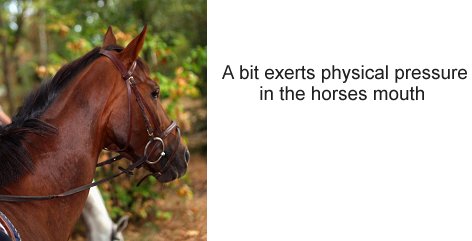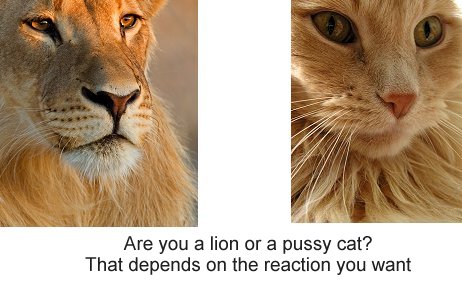There are two main types of Pressure: Physical pressure and Intention pressure (threat).
 Physical pressure: that is the tactile feelings such as the bit against the bars in his mouth or the rope halter bearing down on the poll at his head. It can be as uncomfortable as necessary to move him, or as subtle as an air-light resting of your hand on his joint or muscle line (as in some equine message techniques that produce relaxation).
Physical pressure: that is the tactile feelings such as the bit against the bars in his mouth or the rope halter bearing down on the poll at his head. It can be as uncomfortable as necessary to move him, or as subtle as an air-light resting of your hand on his joint or muscle line (as in some equine message techniques that produce relaxation).
Horse’s are large animals, but not necessarily agile or inventive. They can bully their environment, pushing through brush, bumping each other: In essence, using their size to move things out of their way.
A horse’s natural reaction to physical pressure is to resist it by moving into it. ie: When you lean into a horse’s shoulder in an effort to get his weight off of your foot, he leans right back into you, forcing his full weight onto the hoof that is crushing your toe. Just one instance where it would be nice if you were dealing with a horse who had been taught to yield to pressure. Such a horse would have moved off of your foot the moment you put the slightest pressure on his shoulder.
They have a built-in survival response, which is a “bracing” response. Teaching a horse to yield or relax (not brace) involves time spent on the ground, motivating him to move away and then reinforcing his retreat. (see Release Training)(see Reinforcement Theory ) (see Yielding)
Pressure should not be PAIN.
Two types of Physical Pressure
There is a difference between pushing and driving. Both are physical pressure. However, pushing is a steady pressure that a horse can push back against. It remains on the horse’s body, escalating in intensity until the horse yields to it: Low press, medium press, deep press that is very uncomfortable. (The colt in the video above is being “pushed”)
Driving is a rhythmic pressure that demands movement away from the driver. It is harder to resist because it pulsates. There is nothing to lean back against. Driving pressure escalates from body-bubble “air-tapping” into his space to actual pulsating physical contact: TAP! TAP! TAP!
During the introduction of most training exercises in this manual we use escalating driving pressure to induce a horse to move in a certain direction:
First we use the rope twirl or handy stick to “air-tap” near his body or head causing him a little anxiety at the nearness of the threat: air-tap, air-tap, air-tap (no physical touch), asking him to move away from the “intention pressure” of the rhythmic movement toward his body.
No response?
Escalate to a physical but light tap, tap, tap. Actual physical contact is made but it is not too firm.
Still no response?
Escalate further to Tap, Tap, Tap, which is getting firmer.
If still no response, escalate to TAP!, TAP!, TAP!. This may turn into a physical whack with a very dominant, pushy, or aggressive horse.
After a horse shows you that he understands the request but is just too lazy to do it in a manner with any energy in it, we jump through the driving pressure escalation more quickly:
Request with body language or light hand or leg pressure
Jump to TAP if not performed with energy.
Your Power Bubble: Intention Pressure Personified
 Intention (psychological) pressure: Because horses are prey animals and not predators (that is: hunted instead of hunters), they must always be aware of a carnivore eyeing their body and sizing them up for dinner. If a horse feels threatened by another’s intentions (intention pressure) he will move away from the “pressure“. See Fight or Flight. Intention pressure is usually communicated through body language (your position, your gaze, your energy) but not touching.
Intention (psychological) pressure: Because horses are prey animals and not predators (that is: hunted instead of hunters), they must always be aware of a carnivore eyeing their body and sizing them up for dinner. If a horse feels threatened by another’s intentions (intention pressure) he will move away from the “pressure“. See Fight or Flight. Intention pressure is usually communicated through body language (your position, your gaze, your energy) but not touching.
Horses instinctively watch your body for signs of your intentions. Your body may expand or contract (standing taller or shrinking). Your gaze may be more or less direct or intense. Your voice more authoritative or more gentle. Your use of the whip faster, more energetic or slow and tickling. Your breathing can have a major impact. Power emanates from your diaphragm, and modeling your deep, slow breathing can often calm a tense horse. By the same token, if you raise your energy level in your breathing, you can bring an un-enthused horse up in his own energy level. All of this is deeply connected to his flight or fight instinct.
If you have authority, there is a kind of force-field around your body (an invisible bubble) that they dare not trespass without invitation. Whenever there is energy in your stance or movement, the bubble grows in size, shrinking back smaller as you relax and look away.
Here is an example of a horse who is turning his rear away from a handler who is signalling with his body posture and movement that he has the “intention” of aggressing the horse’s fanny. This pressure was used to teach the horse to keep his rear end away from the handler. When the trainer wants him to stop moving his rear away, he stops leaning in and pointing.
Very sensitive horses watch this bubble closely and react quickly to stay out of its field without invitation. Disrespectful horses trespass into that space, eventually popping the bubble altogether and leaving you vulnerable to their shear size and weight. The colt in the following video was born and raised on the ranch, spoiled by all who passed by. Though still a stallion, he is not dominant or aggressive, he is just disrespectful of my personal space in his eagerness to get close and be rewarded. It is a clear example of a handler who is not using body language to communicate a barrier. I will have to teach him to be more mindful of my personal space soon, as he could easily knock me over or step on me. He’s growing too big for my safety even though he is not at all aggressive.
(I was too casual about my space on the day we took the video. Today I would give the lead a little pop to startle him back a couple of steps (physical pressure). Then relax. Then walk TO him for his rewarding pat instead of him walking into me.)
Proper Release is critical to the learning process. Release is the reward that the rider or trainer gives the horse for executing the proper maneuver. It requires exact timing, which is the hardest part of training for the novice trainer.
Pressure induces some amount of anxiety in the horse, which requires him to do something to feel comfortable again. If the handler has properly pre-planned the pressure, the horse does what is expected, the pressure is released and the horse is allowed to relax into a calm state again.
ie: If, under saddle, he backs up one step when asked to do so, the pressure is immediately released and he finds that a one-step back always brings relief from the pressure of the bit and the rider’s legs. Soon, he heads for that sweet pressure-free spot when he feels the beginning of the cue. See Release Training
Relax is the state where the horse has complied with your request or overcome anxiety and is allowed to work through his nervousness and come down to a calm state. Read more here
Shaping is the term used for GRADUALLY lengthening or fine-tuning a response. ie: After your horse reliably backs up one step, start asking for two. When that is an easy task, ask for three etc. etc. Soon he will back clear across an arena with only the lightest cue. See Shaping for more details
Pressure should not be PAIN.
Horse training and equestrian activities in general can be dangerous. While we try to present relevant and valuable content, under no circumstances does horse-pros.com or its members or contributors take any responsibility for the well-being of any horse or person using a method outlined here.
We certainly don’t know everything. Please share your expertise and experiences. Comment on what is already written or Suggest a Category and Educate us about it. Grow Horse-Pros.com©
